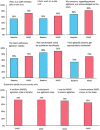The Utilization of a Rapid Agitation Scale and Treatment Protocol for Patient and Staff Safety in an Inpatient Psychiatric Setting
- PMID: 36006571
- PMCID: PMC9402403
- DOI: 10.1007/s11126-022-10001-y
The Utilization of a Rapid Agitation Scale and Treatment Protocol for Patient and Staff Safety in an Inpatient Psychiatric Setting
Abstract
Agitation is a common and potentially dangerous condition requiring rapid recognition and treatment in acute psychiatric units. Prompt intervention can prevent a patient with agitation from harming themselves, harming others, or needing restraints or seclusion. After the review of numerous guidelines, the Modified Agitation Severity Scale (MASS) agitation treatment protocol was developed to identify and manage agitation in an inpatient adult psychiatric setting. This protocol involved modifying an existing agitation scale and pairing scores with a treatment algorithm to indicate which behavioral and medication interventions would be most appropriate. All scoring and interventions were recorded in the electronic medical record (EMR). Three months of data were collected before and after the protocol was implemented. The new, modified scale had high reliability and correlated well with another validated agitation scale. Perceived patient safety was high during both study phases. Nurses' perceptions of safety trended upward after the protocol was implemented, though these differences were not significant, likely due to insufficient power. Although there was no decrease in seclusion events after implementation of the treatment protocol, there was a 44% decrease in restraint events and average restraint minutes per incident. Despite a potential increase in workload for nursing staff, implementation of the protocol did not increase burnout scores. Physicians continued to order the protocol for 55% of patients after the study period ended. These findings suggest that including a rapid agitation assessment and protocol within the EMR potentially improves nurses' perceptions of unit safety, helps assess treatment response, reduces time patients spend restrained, and supports decision making for nurses.
Keywords: (4–6): agitation; Agitation severity scale; Inpatient; MASS; Psychiatric medication; Quality improvement.
© 2022. The Author(s), under exclusive licence to Springer Science+Business Media, LLC, part of Springer Nature.
Conflict of interest statement
The authors have no relevant financial or non-financial interests to disclose.
Figures
Similar articles
-
[The practice of restraint in a psychiatric emergency unit].Encephale. 2004 Jan-Feb;30(1):32-9. doi: 10.1016/s0013-7006(04)95413-9. Encephale. 2004. PMID: 15029074 French.
-
Discontinuing the Use of PRN Intramuscular Medication for Agitation in an Acute Psychiatric Hospital.Psychiatr Q. 2016 Mar;87(1):25-9. doi: 10.1007/s11126-015-9359-1. Psychiatr Q. 2016. PMID: 25869884
-
Protocol for the management of psychiatric patients with psychomotor agitation.BMC Psychiatry. 2017 Sep 8;17(1):328. doi: 10.1186/s12888-017-1490-0. BMC Psychiatry. 2017. PMID: 28886752 Free PMC article.
-
Agitation in the inpatient psychiatric setting: a review of clinical presentation, burden, and treatment.J Psychiatr Pract. 2011 May;17(3):170-85. doi: 10.1097/01.pra.0000398410.21374.7d. J Psychiatr Pract. 2011. PMID: 21586995 Review.
-
Using interventions to reduce seclusion and mechanical restraint use in adult psychiatric units: an integrative review.Scand J Caring Sci. 2019 Dec;33(4):765-778. doi: 10.1111/scs.12701. Epub 2019 May 6. Scand J Caring Sci. 2019. PMID: 31058332 Review.
Cited by
-
Assaults and Microaggressions Against Psychiatric Residents: Findings from a US Survey.Acad Psychiatry. 2024 Aug;48(4):310-319. doi: 10.1007/s40596-024-01933-7. Epub 2024 Jan 30. Acad Psychiatry. 2024. PMID: 38291313
-
Virtual reality for experiential learning: enhancing agitation management skills, confidence, and empathy in healthcare students.Med Educ Online. 2025 Dec;30(1):2542809. doi: 10.1080/10872981.2025.2542809. Epub 2025 Aug 6. Med Educ Online. 2025. PMID: 40765277 Free PMC article.
References
MeSH terms
LinkOut - more resources
Full Text Sources





